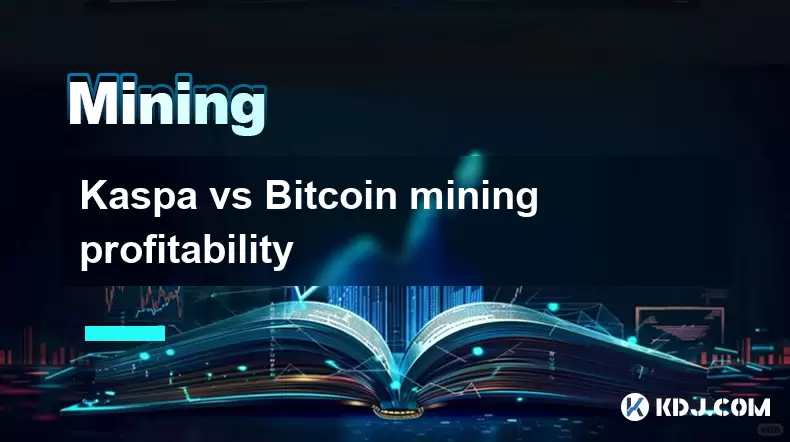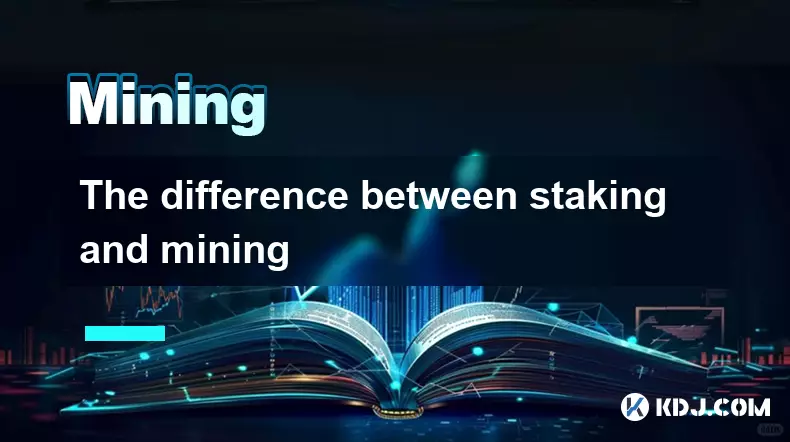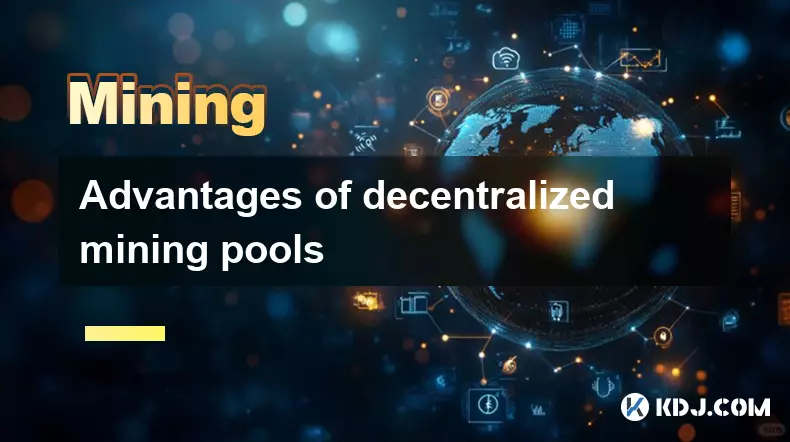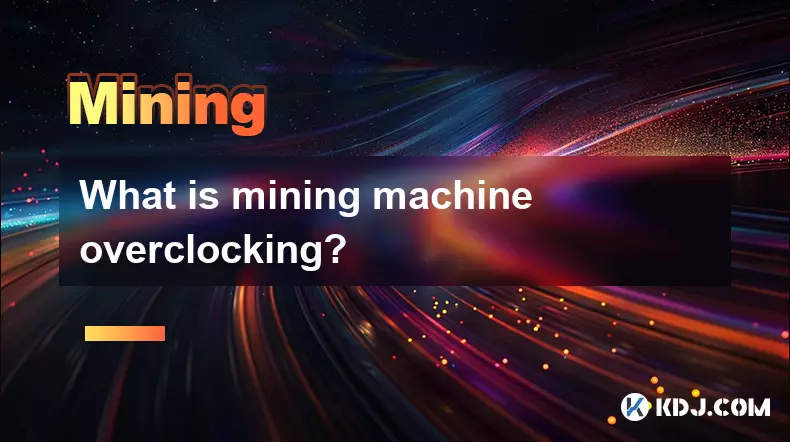-
 bitcoin
bitcoin $123963.239194 USD
1.37% -
 ethereum
ethereum $4529.082464 USD
1.07% -
 xrp
xrp $2.983640 USD
0.71% -
 tether
tether $1.000287 USD
0.02% -
 bnb
bnb $1179.874393 USD
2.99% -
 solana
solana $230.633678 USD
1.55% -
 usd-coin
usd-coin $0.999835 USD
0.03% -
 dogecoin
dogecoin $0.254240 USD
1.34% -
 tron
tron $0.341176 USD
0.15% -
 cardano
cardano $0.842285 USD
0.52% -
 hyperliquid
hyperliquid $48.537896 USD
-0.86% -
 chainlink
chainlink $21.863092 USD
-0.84% -
 ethena-usde
ethena-usde $0.999743 USD
-0.07% -
 sui
sui $3.579561 USD
-0.18% -
 stellar
stellar $0.403418 USD
2.67%
Kaspa vs Bitcoin mining profitability
Kaspa’s GPU-friendly kHeavyHash and 1-second blocks offer accessible, high-throughput mining, while Bitcoin’s ASIC-dominated SHA-256 favors efficiency over decentralization.
Jul 28, 2025 at 03:08 pm

Understanding the Mining Mechanisms of Kaspa and Bitcoin
The mining processes of Kaspa and Bitcoin differ significantly due to their underlying consensus algorithms and network designs. Bitcoin relies on the Proof-of-Work (PoW) mechanism using the SHA-256 hashing algorithm, which has been the standard since its inception in 2009. Miners compete to solve cryptographic puzzles, and the first to validate a block is rewarded with newly minted BTC. This process demands substantial computational power and energy, leading to the dominance of ASIC (Application-Specific Integrated Circuit) miners.
In contrast, Kaspa uses a unique GHOSTDAG protocol combined with PoW, built on the kHeavyHash algorithm—a variant of HeavyHash optimized for resistance against ASICs. This design aims to promote decentralization by allowing GPU (Graphics Processing Unit) mining to remain competitive. The block generation time in Kaspa is extremely fast—every second—compared to Bitcoin’s 10-minute intervals. This high block frequency increases transaction throughput but also affects how mining rewards are distributed and calculated.
Hardware Requirements and Accessibility
When comparing mining profitability, the hardware used plays a crucial role. For Bitcoin mining, profitability is almost exclusively tied to ASIC miners such as the Antminer S19 series. These devices offer hash rates in the range of 100 TH/s (terahashes per second) with power consumption around 3,000 watts. The initial investment can exceed $2,000 per unit, and electricity costs heavily influence net profit.
Kaspa, on the other hand, remains accessible to GPU miners, which lowers the entry barrier. High-end GPUs like the NVIDIA RTX 3090 or AMD RX 7900 XTX are commonly used. A single RTX 3090 can achieve around 3.5 GH/s (gigahashes per second) on kHeavyHash with power draw near 350 watts. Multiple GPUs can be combined in a rig, allowing hobbyists to start mining with a $2,000–$4,000 investment for a 6-GPU setup. The absence of ASIC dominance means retail miners can still participate without being priced out.
Calculating Profitability: Key Metrics
To assess mining profitability, several metrics must be evaluated: hash rate, power consumption, electricity cost, block reward, network difficulty, and coin price. For Bitcoin, profitability calculators such as WhatToMine or CryptoCompare use current data to estimate daily earnings. As of recent data, an Antminer S19j (95 TH/s) might generate $8–$12 per day before electricity, depending on BTC price and network difficulty.
For Kaspa, the same calculators show that a 6-GPU rig (approx. 21 GH/s) could earn $10–$18 per day pre-electricity, assuming KAS trades between $0.05 and $0.10. The network difficulty of Kaspa adjusts more frequently due to its 1-second block time, which can lead to short-term fluctuations in earnings. However, the lower entry cost and ability to use existing gaming hardware make Kaspa attractive for small-scale miners.
Step-by-Step Guide to Setting Up a Kaspa Mining Rig
- Install a compatible operating system such as Windows 10/11 or Linux (Ubuntu) on your mining rig.
- Update all GPU drivers—use NVIDIA GeForce Experience or AMD Adrenalin for optimal performance.
- Download a reliable Kaspa miner such as GMiner, LOKI Miner, or kHeavyHash-miner from official sources.
- Create a Kaspa wallet address using the official Kaspa Wallet (ksw) desktop app or a supported third-party wallet.
- Configure the miner with a command line or config file including:
- Pool URL (e.g., stratum+tcp://pool.kaspa.org:14400)
- Your Kaspa wallet address
- Worker name (e.g., rig1)
- Algorithm set to kHeavyHash
- Launch the miner and monitor hash rate, temperature, and rejected shares via the console.
- Use tools like HWInfo or MSI Afterburner to optimize GPU voltage and core clocks for efficiency.
Step-by-Step Guide to Configuring Bitcoin ASIC Mining
- Unbox and physically set up the ASIC miner in a well-ventilated area with stable power supply.
- Connect the miner to your local network via Ethernet cable; Wi-Fi is not recommended.
- Access the miner’s web interface by finding its IP address through your router.
- Log in using default credentials (often root/admin) and change them immediately.
- Navigate to the mining configuration and input:
- Primary pool: stratum+tcp://btc.pool.com:443
- Wallet address: your Bitcoin wallet (Bech32 format preferred)
- Worker name: asic1
- Save settings and restart the miner.
- Monitor performance through the web dashboard or third-party tools like Awesome Miner.
- Calculate break-even point using your electricity rate (e.g., $0.10/kWh) and daily output.
Network Economics and Reward Structures
Bitcoin’s block reward is currently 6.25 BTC per block, halving approximately every four years (next in 2024). With one block every 10 minutes, this results in 900 BTC mined daily. The high value of BTC means even small hash contributions can yield significant returns, but only for those with efficient hardware.
Kaspa employs a constant block reward of 300 KAS per block, issued every second. This results in 25,920,000 KAS per day. While the per-coin value is much lower, the high inflation rate in the early stages aims to distribute coins widely. The total supply is capped at 28.7 billion KAS, with emission decreasing logarithmically over time. Early mining offers higher relative rewards before market saturation.
Electricity Costs and Efficiency Comparison
Electricity is the largest ongoing cost in mining. Bitcoin ASICs are highly efficient in joules per terahash (J/TH), with modern units achieving 28–30 J/TH. At $0.10/kWh, an S19 consumes about $7.20 per day in power. If daily revenue is $10, net profit is $2.80.
A 6-GPU Kaspa rig drawing 1,200 watts consumes 28.8 kWh daily, costing $2.88 at the same rate. With $15 daily revenue, net profit is $12.12—significantly higher marginally for small operators. However, heat output and noise from multiple GPUs must be managed, especially in residential settings.
Frequently Asked Questions
Can I mine both Kaspa and Bitcoin simultaneously on the same hardware?No. Bitcoin requires ASICs that cannot run GPU algorithms. GPUs used for Kaspa cannot mine Bitcoin due to SHA-256 optimization in ASICs. The hardware is not interchangeable.
Is cloud mining profitable for either Kaspa or Bitcoin?Most cloud mining contracts offer low or negative returns after fees and electricity. Providers often charge premium rates, and transparency is limited. Self-mining with owned hardware typically yields better long-term profitability.
How does network difficulty affect daily earnings?As more miners join, difficulty increases, reducing individual earnings. Bitcoin adjusts difficulty every 2,016 blocks (~2 weeks). Kaspa adjusts continuously due to rapid block times, making earnings more volatile but responsive.
Do I need a separate wallet for each mining pool?No. You can use the same wallet address across multiple pools or rigs. Ensure the wallet supports the coin (e.g., KAS for Kaspa, BTC for Bitcoin) and use secure storage methods like hardware wallets for large balances.
Disclaimer:info@kdj.com
The information provided is not trading advice. kdj.com does not assume any responsibility for any investments made based on the information provided in this article. Cryptocurrencies are highly volatile and it is highly recommended that you invest with caution after thorough research!
If you believe that the content used on this website infringes your copyright, please contact us immediately (info@kdj.com) and we will delete it promptly.
- BlockDAG, DOGE, HYPE Sponsorship: Crypto Trends Shaping 2025
- 2025-10-01 00:25:13
- Deutsche Börse and Circle: A StableCoin Adoption Powerhouse in Europe
- 2025-10-01 00:25:13
- BlockDAG's Presale Buzz: Is It the Crypto to Watch in October 2025?
- 2025-10-01 00:30:13
- Bitcoin, Crypto, and IQ: When Genius Meets Digital Gold?
- 2025-10-01 00:30:13
- Stablecoins, American Innovation, and Wallet Tokens: The Next Frontier
- 2025-10-01 00:35:12
- NBU, Coins, and Crypto in Ukraine: A New Yorker's Take
- 2025-10-01 00:45:14
Related knowledge

The difference between staking and mining
Sep 24,2025 at 05:18am
Understanding Staking in the Cryptocurrency Ecosystem1. Staking involves holding funds in a cryptocurrency wallet to support the operations of a block...

How to participate in testnet mining?
Sep 22,2025 at 09:18am
Understanding Testnet Mining in the Crypto Ecosystem1. Testnet mining is a method used by blockchain developers to simulate real-world conditions on a...

How to dispose of abandoned mining machines?
Sep 19,2025 at 08:19pm
Assessing the Condition of Abandoned Mining Rigs1. Begin by inspecting each mining machine for visible damage, corrosion, or missing components. Machi...

How to identify high-quality mining pools?
Sep 21,2025 at 03:19pm
Reputation and Track Record1. A mining pool’s reputation is built over time through consistent performance and transparency. Pools that have operated ...

Advantages of decentralized mining pools
Sep 20,2025 at 04:36pm
Enhanced Security and Resistance to Censorship1. Decentralized mining pools operate on blockchain-based smart contracts, eliminating the need for a ce...

What is mining machine overclocking?
Sep 21,2025 at 07:19pm
Understanding Mining Machine Overclocking1. Mining machine overclocking refers to the process of increasing the operating frequency of a cryptocurrenc...

The difference between staking and mining
Sep 24,2025 at 05:18am
Understanding Staking in the Cryptocurrency Ecosystem1. Staking involves holding funds in a cryptocurrency wallet to support the operations of a block...

How to participate in testnet mining?
Sep 22,2025 at 09:18am
Understanding Testnet Mining in the Crypto Ecosystem1. Testnet mining is a method used by blockchain developers to simulate real-world conditions on a...

How to dispose of abandoned mining machines?
Sep 19,2025 at 08:19pm
Assessing the Condition of Abandoned Mining Rigs1. Begin by inspecting each mining machine for visible damage, corrosion, or missing components. Machi...

How to identify high-quality mining pools?
Sep 21,2025 at 03:19pm
Reputation and Track Record1. A mining pool’s reputation is built over time through consistent performance and transparency. Pools that have operated ...

Advantages of decentralized mining pools
Sep 20,2025 at 04:36pm
Enhanced Security and Resistance to Censorship1. Decentralized mining pools operate on blockchain-based smart contracts, eliminating the need for a ce...

What is mining machine overclocking?
Sep 21,2025 at 07:19pm
Understanding Mining Machine Overclocking1. Mining machine overclocking refers to the process of increasing the operating frequency of a cryptocurrenc...
See all articles










































































